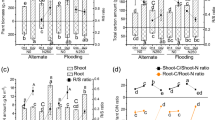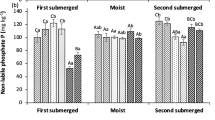Summary
Oryza sativa Loisel cultivar Mars., a common lowland rice variety was grown under controlled soil redox conditions (Eh) and acidity (pH). The effect of two variables (Eh and pH) on growth, anaerobic root respiration, and uptake of added labelled nitrogen, was investigated. Plant growth, estimated by dry weight showed significantly higher growth under reducing sediment redox potentials (−200 mV and 0 mV) and at a soil pH of 6.5 Using the activity of the inducible enzyme alcohol dehydrogenase (ADH) as an indicator of anaerobic root respiration, a decrease in redox potential resulted in an increase in root ADH. However, growth paralled increases in anaerobic root respiration suggesting nitrogen transformation in the soil to be a primary parameter governing growth. Labelled nitrogen uptake which was greater under anaerobic conditions apparently led to greater growth of lowland rice in the highly reduced or anaerobic soil treatments.
Similar content being viewed by others
References
Bremner J M 1965 Total nitrogen.In Methods of Soil Analysis. Ed. C A Black. Am. Soc. Agron., Madison pp 1149–1178.
Chaudhry M S and McLean E O 1963 Comparative effects of flooded and unflooded soil conditions and nitrogen application on growth and nutrient uptake by rice plants. Agron. J. 55, 565–567.
Crawford R M M 1969 The physiological basis of flooding tolerance. Berichte der Deutschen Gesellschaft 82, 111–114.
DeLaune R D, Smith C J and Tolley M D 1984 The effect of sediment redox potential on nitrogen uptake, anaerobic root respiration and growth ofSpartina alterniiflora Loisel. Aquat. Bot. 18, 223–230.
Jackson M B, Herman B and Goodenough A 1982 A examination of the importance of ethanol in causing injury to flooded plants. Plant Cell Environ. 5, 163–172.
John C D and Greenway H 1976 Alcoholic fermentation and activity of some enzymes in rice roots under anaerobiosis. Aust. J. Plant Physiol. 3, 325–336.
Jugsujinda A and Patrick W H Jr 1977 Growth and nutrient uptake by rice in a flooded soil under controlled aerobic-anaerobic and pH conditions. Agron. J. 69, 705–710.
Kawase M and Whitmoyer R E 1980 Aerenchyma development in waterlogged plants. Am. J. Bot. 67, 18–22.
Keeley Jon E 1978 Malic acid accumulation in roots in response to flooding: evidence contrary to its role as an alternative to ethanol. J. Environ. Bot. 29, 1345–1349.
Keeley J E and Franz E H 1979 Alcoholic fermentation in swamp and upland populations ofNyssa sylvatica: temporal changes in adaptive strategy. Am. Nat. 113, 587–591.
Keerthisinghe G, Mengel K and De Datta S K 1984 The release of non-exchangeable ammonium (15N labelled) in wetland rice soils. Soil Sci. Soc. Am. J. 48, 291–294.
Kilham O W and Alexander M 1984 A basis for organic matter accumulation in soils under anaerobiosis. Soil Sci. 157, 419–427.
Lee K K, Holst R W, Watanabe I and App A 1981 Gas transport through rice. Soil Sci. Plant Nutr. 27, 151–158.
Lin C K 1946 Effect of oxygen and sodium thioglycollate on growth of rice. Plant Physiol. 21, 304–318.
McManmon M and Crawford R M M 1971 A metabolic theory of flooding tolerance: the significance of enzyme distribution and behavior. New Phytol. 70, 299–306.
Mendelssohn I A, McKee K L and Patrick W H Jr 1981 Oxygen deficiency inSpartina alterniflora roots: metabolic adaptation in anoxia. Science 214, 439–441.
Patrick W H Jr and Reddy K K 1977 Fertilizer nitrogen reactions in flooded soils. Proc. Int. Seminar on Soil Environment and Fertility Management in Intensive Agriculture. Tokyo, Japan, pp 275–281.
Pradet A and Bomsel J L 1978 Energy metabolism in plants under hypoxia and anoxia.In Plant Life in Anaerobic Environments. Ed. D D Hook and R M M Crawford, Ann Arbor, Michigan, pp 89–118.
Racker E 1957 Methods in Enzymology, Vol. 1 Ed. S P Colowick and N O Kaplan, Academic Press, New York, pp 500–503.
Reddy C N, Jugsujinda Aroon and Patrick W H Jr 1976 System for growing plants under controlled redox potential-pH conditions. Agron. J. 68. 987–989.
Senewiratne S T and Mikkelsen D S 1961 Physiological factors limiting growth and yield ofOrzyza sativa under unflooded conditions. Plant and Soil 14, 127–146.
Shimomura S and Beevers H 1982 Alcohol dehydrogenase inactivator from rice seedlings. Plant Physiol. 71, 742–746.
Smith K A and Jackson M B 1974 Ethylene, waterlogging and plant growth. Agric. Res. Council Letcombe Lab. Ann. Rep. 1973, pp 60–75.
Smith A M and ap Rees T 1979 Pathways of carbohydrate fermentation in the roots of marsh plants. Planta 146, 327–334.
Stansel J W 1975 The rice plant—its development and yield.In Six Decades of Rice Research in Texas. Agric. Expt. Sta. in cooperation with U.S. Dept. of Agric., Monogr. 4, pp 9–21.
Vartepetian B B, Andreeva I N, Maslova I P and Davtian N G 1970 The oxygen and ultrastructure of root cells. Agrochimica 15, 1–19.
Webb T and Armstrong W 1983 The effects of anoxia and carbohydrates on the growth and viability of rice, pea and pumpkin roots. J. Expt. Bot. 34, 579–603.
Author information
Authors and Affiliations
Rights and permissions
About this article
Cite this article
Tolley, M.D., Delaune, R.D. & Patrick, W.H. The effect of sediment redox potential and soil acidity on nitrogen uptake, anaerobic root respiration, and growth of rice (Oryza sativa). Plant Soil 93, 323–331 (1986). https://doi.org/10.1007/BF02374283
Received:
Revised:
Issue Date:
DOI: https://doi.org/10.1007/BF02374283




